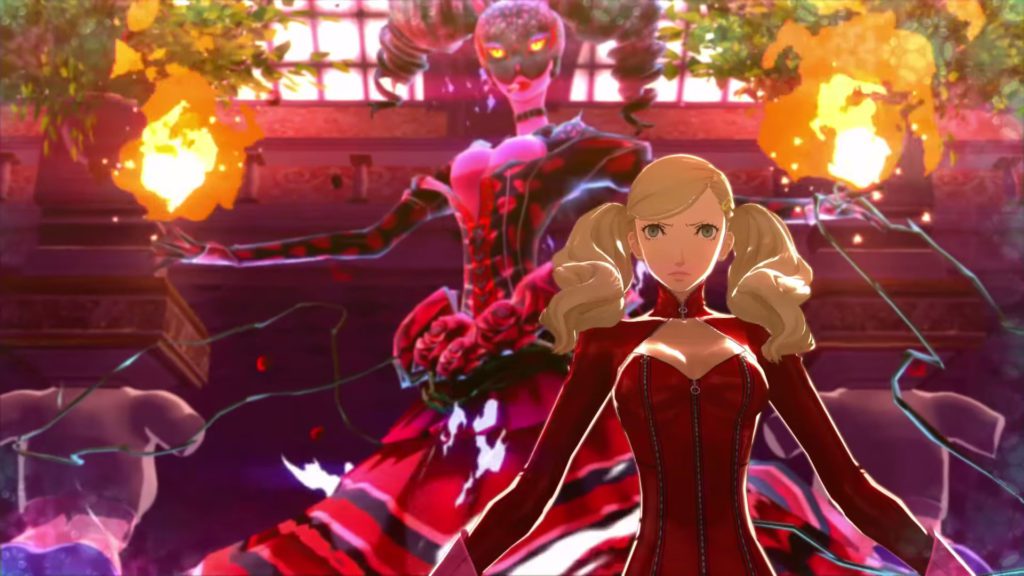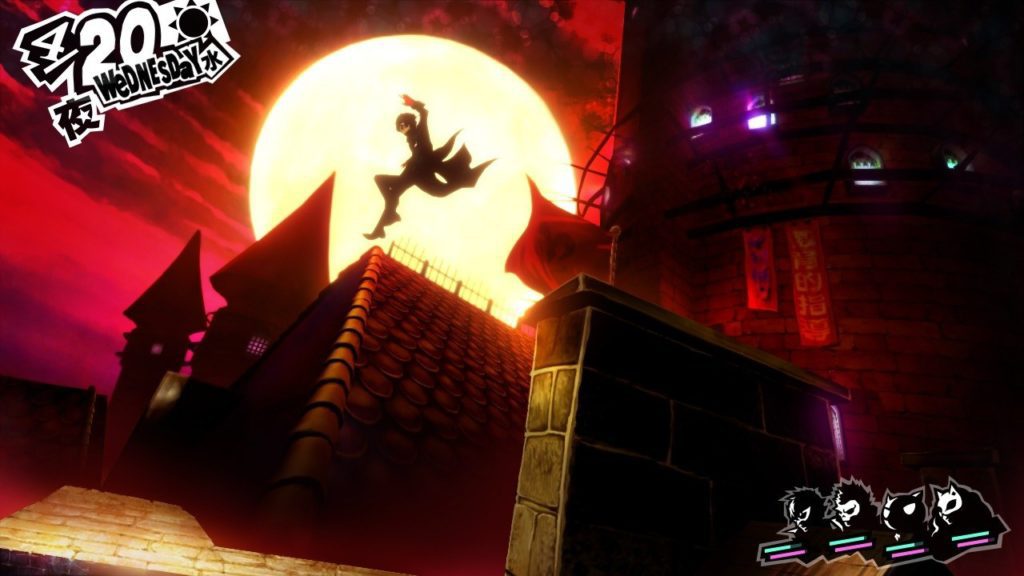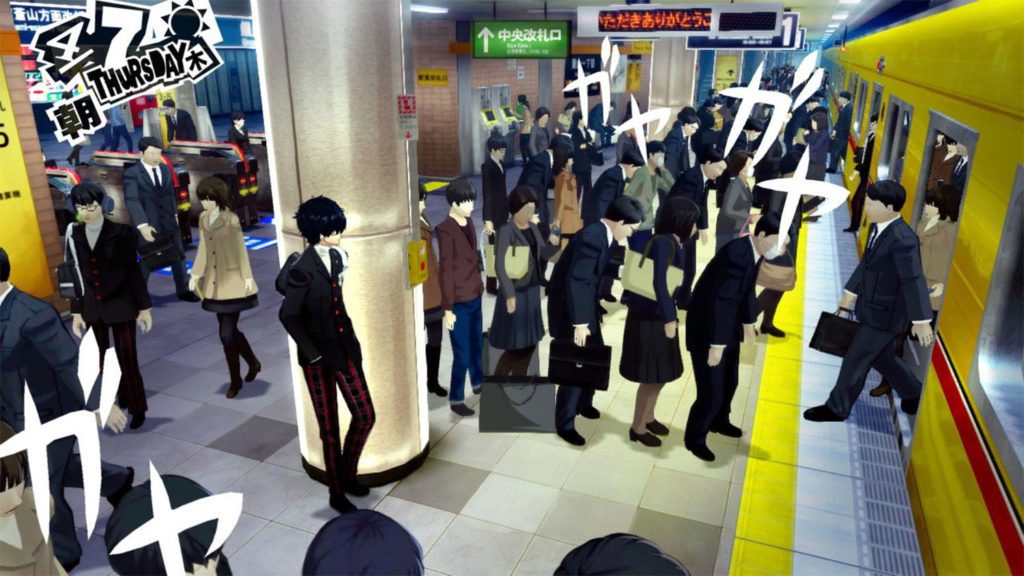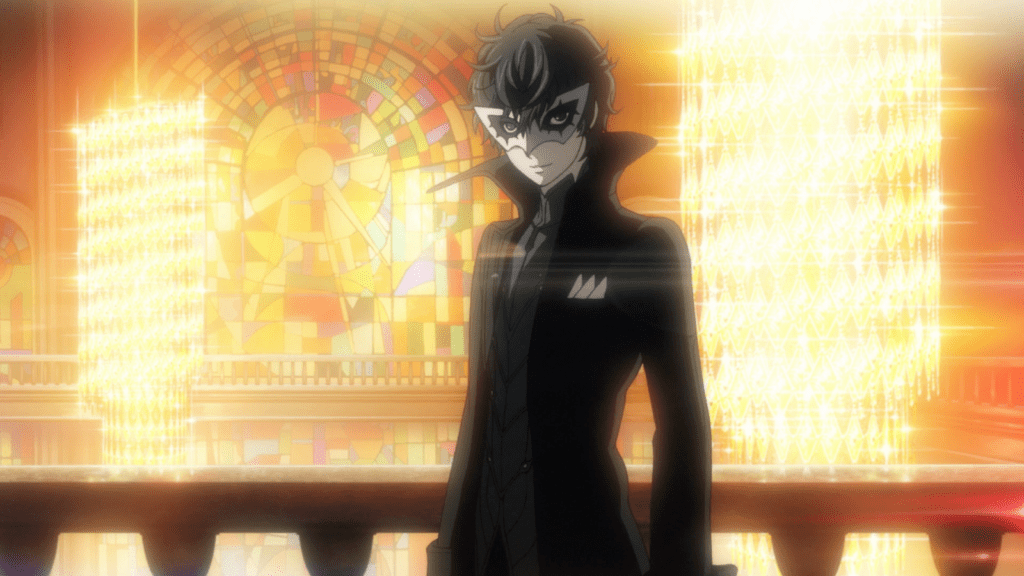Still readjusting to the clean air after a month submerged beneath the haze of the Inaba backwoods, Persona 5 arrived through the letterbox and threatened to shroud me beneath its own blanket of obsession. For as soon as the outer-wrapping had been torn away and the plastic case cracked open for the very first time, the possibility of another Persona game eating away at the day’s light felt all too familiar. Only a month prior, Persona 4 Golden had duly siphoned 75 joyful hours from me without pause. Rumblings that Persona 5’s numbers would dwarf that of Golden forced me to free up the calendar a little. Persona 5 it seemed, was just the kind of game that you plan ahead for.
Persona 4 Golden on the other hand was a purchase made out of impulse. Tantalised by the red and black gloss accenting the pre-release advertisements of its successor, I saw in Golden both an opportunity to cut my teeth within the Persona series, as well as a fitting reason to dust off my neglected PlayStation Vita in the hope of finding a game that could outright redeem its dormancy. And from the moment the chimes of its piano-infused intro bled through that inimitable harmonica shuffle, Persona 4 Golden became exactly that. It was a game that detailed a colourfully righteous pursuit of truth, even in spite of a threat that was difficult to comprehend. And only through repelling fear in unity were the warriors at its heart able to succeed. Though as structural similarities reappear in the sequel, motives differ; the seeking of truth was now a defiance of the despised norm. The fog had lifted, but the evil remained.
In Persona 5, you fulfil many roles: you’re a student, a thief, a loyal friend and a wild card. But before all of that, you’re a castaway sent to Tokyo in order to serve probation following a misdemeanour. The game’s protagonist, Joker (as per his codename) simply caught the ire of the wrong person when trying to do the right thing – a foreboding mistake, given the central themes that permeate throughout. It’s from this unavoidable occurrence that apathy becomes ignorance, and ignorance, disdain. So removed from the world of the tortured and the terrible was Joker before his attempted kindness. And nonexistent were the fires that burned within the next pawn in Igor’s great game.
The story of Persona 5 is one of reforming a blighted society by way of systematically targeting those most responsible for its ills. And the next in line charged with leading a rebellion against fate is Joker, the character that you will spend a hundred-or-so hours forging into the scourge of Tokyo’s greedy, corrupt, and narcissistic. These unappetising traits are just a few of those that give life to shadows; dangerous beings born of twisted desires that reside within the Metaverse. The strongest of these shadows house themselves inside palaces, and it’s these palaces that serve as Persona 5’s dungeons – spectral beacons of impurity lorded over by the worst aspect of ourselves. In essence, you are challenged by your mysterious handler Igor to adjust the predetermined future by knocking these monuments of avarice to the ground, defeating the shadow at their heart, and forcing a substantial cognitive change upon the shadow’s real-world equivalent. And to accomplish all of that, you’ll need to keep your wits as sharp as your blade, and have a host of allies willing to fight at your side.
It’s initially a lot to take in, to which the writing rarely misses an opportunity to clarify its own lore and iron-out any contradictions. Before you have a chance to ask questions such as why palaces and the beings within them act and look the way that they do, it’s already been answered in a hurriedly preventative fashion. And it’s perhaps why, although remaining a vital part of establishing what exactly the Metaverse and Personas are, some of the forced explanation is enough to pull you out of any given conversation. Save for this somewhat ham-fisted revelatory technique, Persona 5’s story is as temperate as it is energetic, the social aspects and the shadow culling each as purposeful and enjoyable as the other.
FOR EVERY PALACE, A RULER. FOR EVERY RULER, AN INSATIABLE DESIRE
You’ll navigate Persona 5’s narrative a month at a time, dividing around three of those four weeks between unavoidable commitments like attending school, and electable activities such as fostering relationships with your growing entourage of allies. The remainder of the month is spent trading in your school uniform for the mask of the thief, as you hone in on a target and assault the shadowed palace that they hold dominion over within the Metaverse. Combat in Persona 5 is typically slick, yet just as satisfying as slicing apart clutches of shadows in a bid to confront their ruler is the narrative direction that propels you. In the weeks before ever stepping foot inside the lavish castle of the abusive teacher Kamoshida, or the golden gallery of the deceitful artist Madarame, you’ll become readily accustom to their vile ways and the effect that they’ve had on others through cut-scenes that bookend schooldays and social hangouts. And it all helps to serve the growth of hatred with which Persona 5 decorates its villains, their nefarious acts unfurling over the course of weeks, their reach extending as far as those that you’ve begun to care about.
The sinners of Persona 5 all espouse the same contempt for youth and unchecked power that holds strong as a recurring theme, though it’s their individuality in direction and motive that allows each of them to paint their own distinct shade of evil. Commonality depicts them all as wrongdoers, but to ascend the floors of their uniquely tailored palaces and face them in a gruelling final battle is to see the full extent of the depth placed in their characterisation. The structure of their palace forms a grand visual representation of their broken psyche; the manifestation of their treasure outlines the shape of their lust; their final shadowed form is a superbly hyperbolic portrayal of their madness. The detail plied to outlining every rise and fall of the game’s deadliest monsters is staggering. There’s so much life to the duelling personalities of the real-world culprits and their shadowed hidden forms, so many grounded truths even in spite of the colourful exaggeration that Persona games thrive on. But even when the in-game clock begins ticking faster than you would like, Persona 5 affords ample opportunity to embolden its villains and make your role in their eventual demise feel wonderfully fulfilling. And through meaningful depiction comes a gratifying victory, however irredeemable many of them may seem.
To invade a palace is to make a beeline for the treasure that resides in its deepest recesses. Once the treasure has been identified, it’ll take another full day before you can confront and battle its owner for the right to rid the Metaverse of them and their palace entirely. That means you will want to secure your route through the dungeon in as few trips as possible, as the shadows that you will engage along the way each serve to whittle down your team’s collective energy. Combat in Persona 5 forces players to fight efficiently and plan accordingly – you may take up to three confidants with you leaving the others on the sideline, but as you cannot save progress outside of sparsely located safe rooms, one mistake could see you forfeit an hour or more of progress. Exploiting the weaknesses of shadows is just good practice. Stocking up on medicinal supplies before ever entering the dungeon is even better.
The utilisation of turn-based combat plays perfectly into the formidable challenge that every fight promises. Next to the health of every member of your party, you also have to take into account their ‘SP’, the fuel with which Persona attacks are called upon. An enemy shadow weak to ice may shiver at the touch of a ‘Bufu’ attack, but executing that move may mean a self-heal with the ‘Dia’ ability a little later isn’t possible. Combat is often unforgiving, particularly as your team starts to run on fumes when you reach the latter stages of a dungeon. One particular new mechanic introduced in Persona 5 can thankfully offer a valuable reprieve in the most dire of circumstances. Shadows fatally injured tend to beg for their lives rather than fight back, allowing Joker and crew to shake them down for money, a healing item or even the use of themselves as a Persona. Collecting Personas is a trait unique to the wild card enigma that heads up the Phantom Thieves, and while all allies may be confined to their single Persona, Joker can call upon the powers of many, broadening his arsenal all the more with every successful negotiation.
Already tremendously manageable as-is, the ‘Hold Up’ dynamic adds an extra layer of tactical flair to combat that allows for a quickened victory, while also serving as a conduit for the oh-so stylish ‘All Out Attack’ team finisher. And as battles bleed into one another over the course of one solitary dungeon delve, the aesthetic artistry of Persona 5 shines from every angle. Idle in deliberation, your team face their enemies flanked by the exploded lettering of a tactics menu torn straight from a comic book. Attacks themselves are accented by flashes of neon spatter and crisp, swift movements that range from sword strikes to shotgun blasts. And the vibrant personalities of your fellow confidants beam from the roulette red and black stylised manga art that foretells a coming slaughter of shadows.
The game makes use of several distinct visual forms, but all adhere to the consistent design ethos of the Phantom Thieves and their individuality. Three-dimensional cut-scenes lean on the emotive aspects of the characters in focus: their expressive movements, the energy behind consistently brilliant voice-work. A bubbling vignette brings into frame the transformations of your cohorts, the desperation behind their defining emotional break. And animated cut-scenes detail a different side of the Thieves, lessening the emphasis on dialogue, instead letting the subtleties of the characters and the pastel-painted environments speak for themselves. The menagerie of aesthetic styles only serves to emphasise the confidence behind the game’s art direction – Persona 5 is no graphical behemoth, but it never needs to be when it can rely such strength in evocation from every pore.
Even throughout its many menu interfaces does Persona 5 inject life into every facet of its experience. The patchwork lettering of the Phantom Thieves’ calling cards is present as you purchase supplies from shops and check on your confidant progress. And when you enter those menus, there’s little wasted motion as the three-dimensional person in front of you transitions into a dark silhouette stark against a vibrant neon background. The manga-centric flat design, in alleviating the dreariness of the typical RPG menu, then exemplifies the fluidity of all the game’s parallel systems. Not only does the boundless visual character elevate the ordinary and the mundane, it too holds a practical significance in tethering together every aspect of gameplay. Persona 5 may be an inherently linear game, but that linearity is buoyed by the level of care plied to its every individual part.
TEENAGE LIFE PREVAILS BEYOND SHADOWS – JOBS AWAIT, EXAMS BECKON
Progression in Persona 5 isn’t just measured by the increasing sense of strength that you garner from regular combat. Your journey is best gauged instead by the company you keep, and the altered perception with which you begin to view existing characters. Every possible confidant in Persona 5 has 10 total levels to advance through, each unravelling that little bit more about them. And your potential confidants aren’t just limited to those who fight alongside you in battle, either. Tokyo and its winding districts are full of people looking for that right type of person to confide in, and through exploration as well as natural progression, a full stock of allies all supporting the Phantom Thieves can help elevate your outfit from a state of purgatorial anonymity, to worldwide renown.
As an ascent through confidant rankings directly unlocks several abilities to utilise in dungeons, you’d be forgiven for initially parting with your free time if only to broaden your Phantom Thieves repertoire. The strength of confidant rankings doesn’t lie solely in the acquiring of new abilities however, rather in the unique characterisation of every ally that blossoms as you begin to spend more time with them. These are the disaffected and the disenfranchised, those indirectly at the mercy of the Metaverse and the shadows within. As with our protagonist, the true extent of their rationale in aligning with the Phantom Thieves often comes from unexpected means. As shadows and Personas threaten to loose the game from its foundation of reality, the act of lifting the burdens from the shoulders of one friend, and advising another on a choice of career path adds a refreshing clarity to it all. Applying consideration to a life after shadows makes Igor’s game seem all the more superfluous, but the adverse affect is also true of your confidants. Getting to know who they really are encourages them, empowers them. It makes the justice dealt by the Thieves seem all the more necessary, and emphasises the game’s most championed mantra – fate is not absolute, and if we have the means to change it, we will. Together.
And by completing social links, not only does gratification come in the form of aiding a potential ally, but also in simply helping out a new friend. The hands of fate may have brought you together, but it’s up to the player how closely-guarded each friendship remains. Reaching the final stages of affinity with a confidant brings with it a sense of pride, yet it’s the fishing trips, study sessions and afternoon coffees along the way that best prepare you for the palaces ahead. As the Metaverse eternally hangs in the distance, it’s during breaks with friends that Persona 5 is at its most melancholic. Drinks in the diner with your cohorts tempers the pace, the pattering of rain and warming glow of potted candles depicting a mellow ambience as you flick through study notes. The calming jazz eases any lingering thoughts of fights yet to come, the breaking of a softened voice from behind the strings heralding the passage of one day into the next.
In its fluidity of mechanics and unmistakably crisp veneer, Persona 5 is an experience that thrives on imparting its whole. It’s in the navigating of a menu, the destruction of a palace and the beginning of a romantic relationship. Every aspect of the game is tailored for practicality and serving of a greater purpose. Woven between its technical feats are ones of great meaning – the game’s orchestration of defiance is carried out by Joker and his allies, then reiterated in its graphical stylisation and magnificent soundtrack. And in its painstakingly refined form exists an RPG that, while lacking the freedom of a typical open world, so adamantly makes you feel beholden to a city losing itself within the great game of fate. And so it’s up to the teenagers of Tokyo to loosen the grip of inevitability. Around every corner lies another wonder of design, imagination, worth. It’s difficult to stop thinking about Persona 5 – it’s an RPG for its time, and a remarkable experience until the very end.



